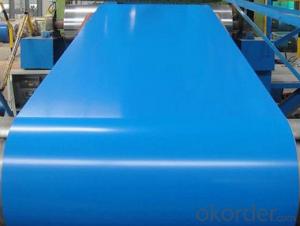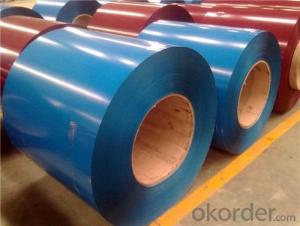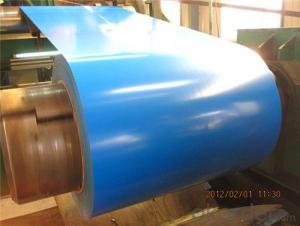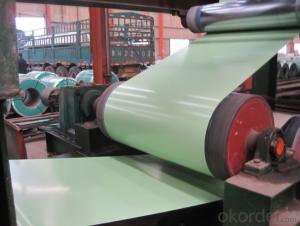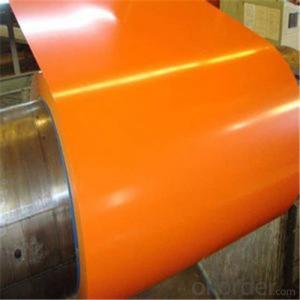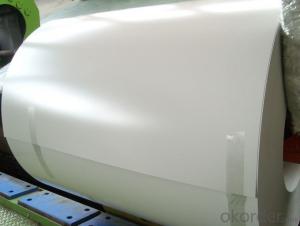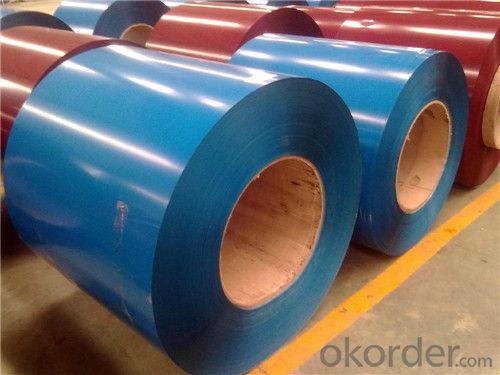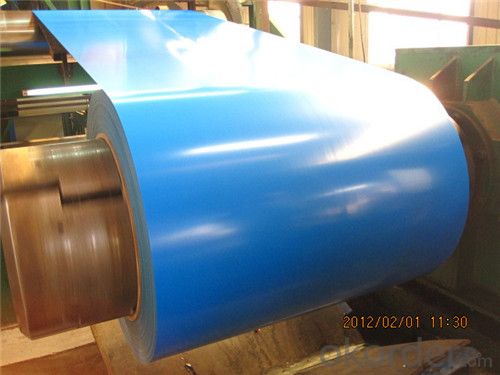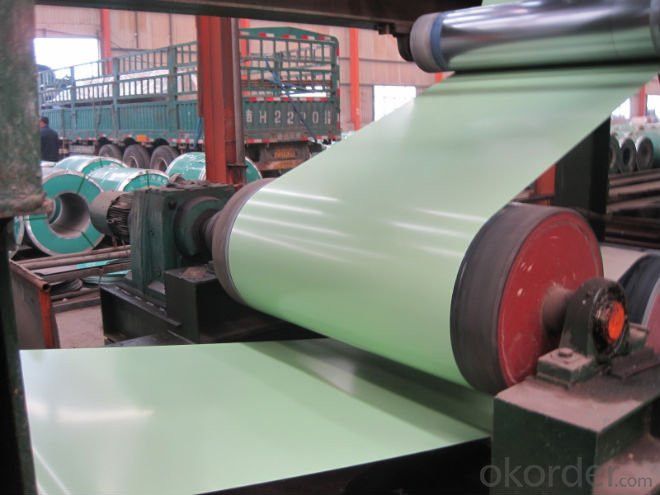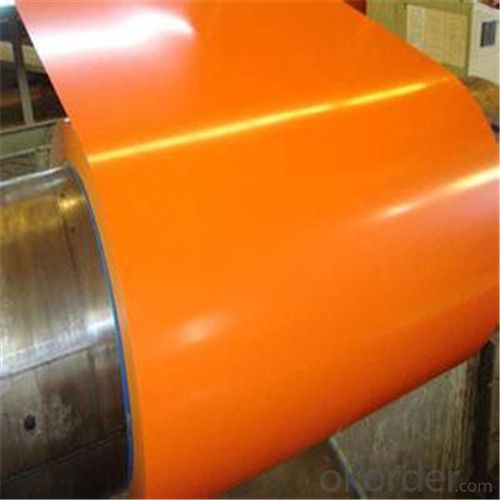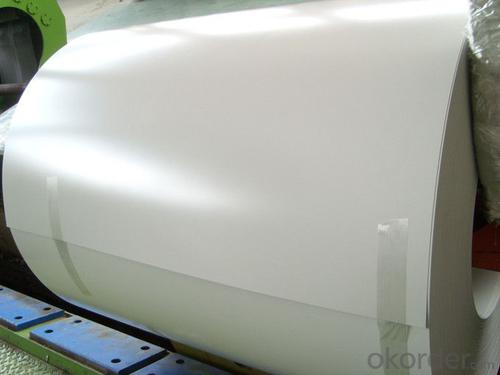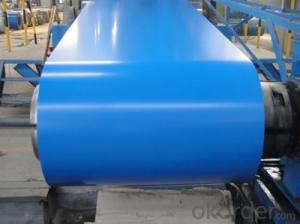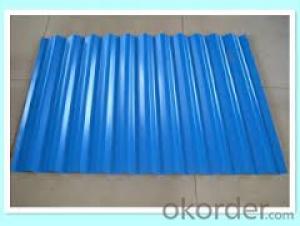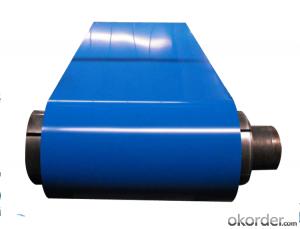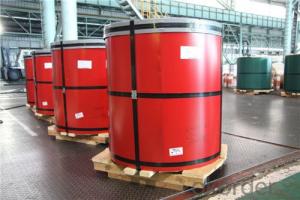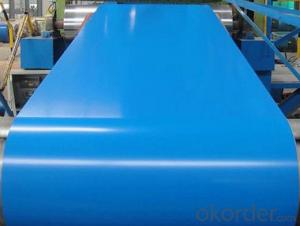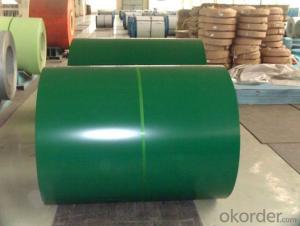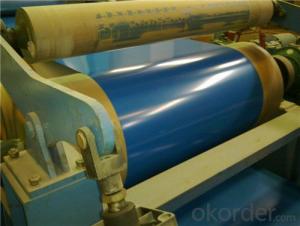ASTM Z60 Rolled Prepainted Steel Coil for Construction
- Loading Port:
- Shanghai
- Payment Terms:
- TT OR LC
- Min Order Qty:
- 50 m.t.
- Supply Capability:
- 30000 m.t./month
OKorder Service Pledge
OKorder Financial Service
You Might Also Like
Structure of ASTM Z60 Rolled Prepainted Steel Coil for Construction
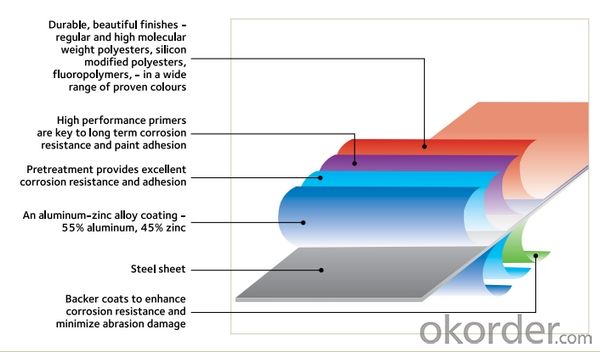
Description of ASTM Z60 Rolled Prepainted Steel Coil for Construction
BMT Prepainted Rolled Steel Coil is a kind of coated steel coil/sheet. With the cold rolled steel of different strength and thickness as substrate, it is produced through applying Zn coating on both faces by hot dip process. Its surface has bright silver color and regular embossed-like figure, which are highly decorative.
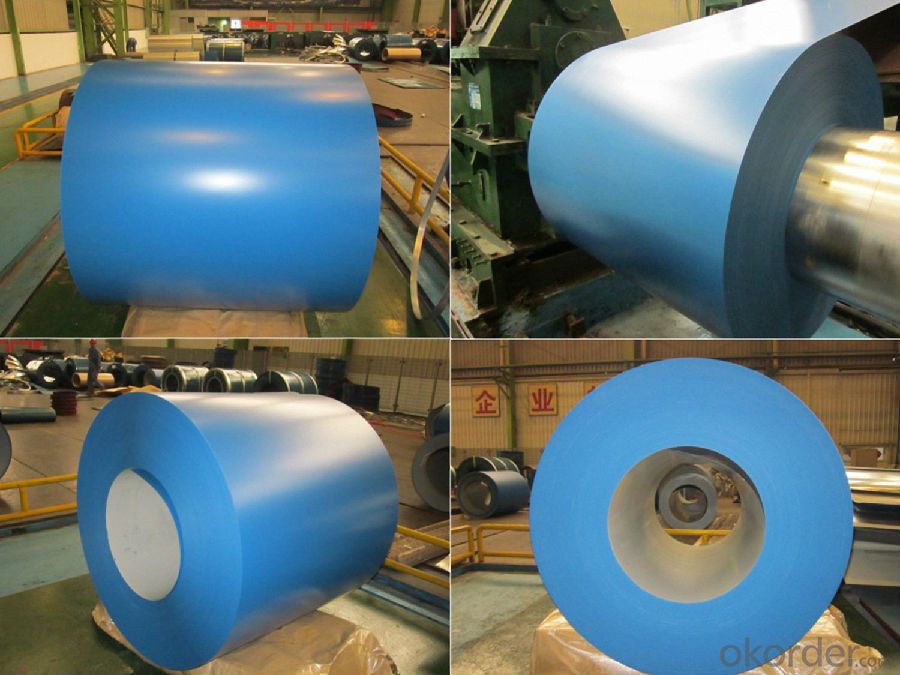
Main Feature of ASTM Z60 Rolled Prepainted Steel Coil for Construction
1.Corrosion resistance: It mainly depends on the aluminum protection. When the zinc being worn, the aluminum will form a dense layer of aluminum oxide, resist corrosion material to prevent further corrosion inside.
2. Heat reflective: Galvanized steel plate heat-reflective high rate is twice as galvanized steel, often used to make insulation materials.
3. Economy: Because density of 55% AL-Zn is smaller than the density of Zn, so in the same weight and thickness of Galvanized zinc layer, aluminum-zinc steel plate is larger area more than 3% of galvanized steel sheet.
Applications of ASTM Z60 Rolled Prepainted Steel Coil for Construction
1. Construction and building: roofing; ventilating duct; handrail; partition panel
2. Electric appliance: refrigerator; washing machine; refrigerator..
3. Transportation: oil tank; road sign; etc.
4. Agriculture:barn; etc.
5. Others: vending machine; game machine; etc.
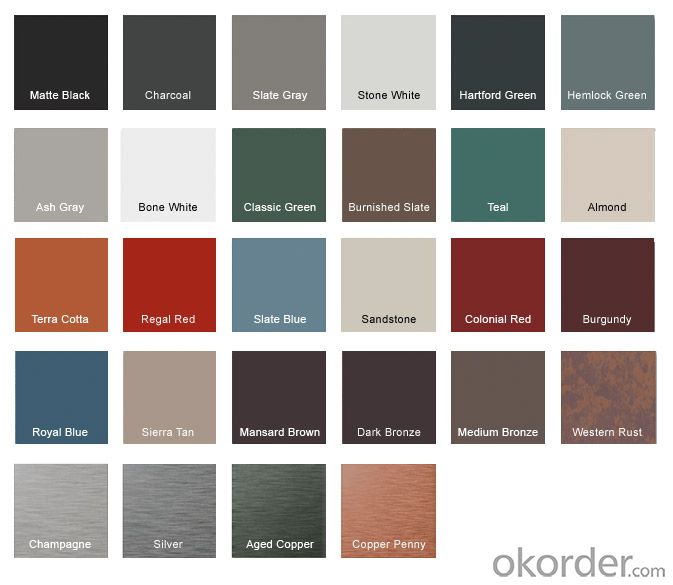
Specifications of ASTM Z60 Rolled Prepainted Steel Coil for Construction
Product | ASTM Z60 Rolled Prepainted Steel Coil for Construction |
Material Grade | SGCC / SGCH / DX51D+AZ, etc |
Thickness | 0.3-3.5mm |
Width | 600-1250mm |
Tolerance | Thickness: +/-0.02mm , Width:+/-2mm |
Zinc-coating | AZ35-80g/m2 |
Technique | Raw material: Hot rolled steel coil > Cold rolled>hot dipped galvalume |
Surface | Coated, prepainted galvanized/galvalume/ hot dopped galvanized steel |
Spangle | Regular spangle , small spangle, zero spangle |
ID | 508MM 610MM |
Coil weight | 25MT max |
Export package | Cardboard inner sleeves, Waterproof paper, galvanized steel covered and steel strip packed |
FAQ of Z60 Rolled Prepainted Steel Coil for Construction
We have organized several common questions for our clients,may help you sincerely:
1. What is your MOQ ?
Our MOQ is 50mt. And there is more discount if you order like 1000 tons and more. The more appropriate payment term your can offer, the better price we can provide.
2. How do you promise the quality of the steels?
We have established the international advanced quality management system ,every link from raw material to final product we have strict quality test;We resolutely put an end to unqualified products flowing into the market. At the same time, we will provide necessary follow-up service assurance.
3. What is the substrate for steel tiles?
Hot dipped galvanized or gavalume, pre-painted galvanized.
4. What is your package?
One coil per bundle, inner is the protecting humidity-proof wax paper. Medium is plastic film. Outer is sackcloth or compound paper packing. Coil to be laid on single type pallet (one pile per pallet)
- Q: If steel content is too cheap, what content should I be looking for? I don't think I could find something like a VG-10 here...
- I am a former chef and have used Chinese chefs knives, different types from cleavers, even french knives, they are mostly carbon steel, and are made with a cold forged process, they are as good as the European knives and are marketability cheaper, I have one a french knife a 8 one with a green non porous handle. I like it, it is light weight and very well made, and keeps an edge quite well, just look for the better type available.
- Q: Maybe it is obvious. But i have thought alot about it.I thought steel at a cool temperature was unbreakable. I am not one for science or physics or engineering (i am a political science major). But i don't understand why the planes that struck the world trade center on 9-11 didn't just dent the side and fall,How did the place break the steel? Was it the velocity? Is steel easily broken?I realized that i wasn't taught how the planes broke the steel, and that no one ever asked. I searched the web and i couldn't find the answer or even anyone who had asked the question before.(i don't care about conspiracy theories, i just want scientific facts)
- I saw a one-hour program about this on PBS a couple of years ago. The buildings were constructed with the concrete-clad steel supporting columns at the center of the buildings, with a relatively thin lattice of steel struts along the outer wall. When the planes hit, they sheered through the thin steel struts easily by sheer momentum, while, at the same time, the thin steel stripped off the wings. The bodies of the planes got as far as the supporting columns in the center of the buildings, but were stopped there. The heaviest, densest pieces, the engines, went completely through the buildings and popped out the other side. It's important to understand that even light materials can cut through metal, if the light material is going fast enough. I saw this first hand, when I was in the Navy and stationed on board ship. We had a helicopter crash on our flight deck during heavy weather. The blades were made of light, carbon-composite material, but they were going so fast that they cut through the aluminum deck. I still have photos of that damage.
- Q: How do steel coils contribute to strength and stability in structures?
- Steel coils are essential components in many structures due to their significant contribution to strength and stability. The inherent properties of steel, combined with the unique design of coils, make them an ideal choice for enhancing the structural integrity of various applications. Firstly, steel itself is renowned for its exceptional strength. It has a high tensile strength, which means it can resist large amounts of tension without breaking or deforming. When steel is formed into coils, it further enhances its strength by distributing the load evenly across the entire structure. This uniform distribution of force helps prevent localized stress concentrations, ensuring that the structure can withstand heavy loads and external pressures more effectively. Additionally, steel coils provide stability to structures by offering rigidity and resistance against deformation. Steel is known for its stiffness, which prevents excessive flexing or bending under loads. The tightly wound coils create a robust and compact structure that can efficiently resist dynamic forces, such as wind, earthquakes, or vibrations. This high resistance to deformation minimizes any potential damage to the structure, thereby maintaining its stability and integrity. Moreover, steel coils also contribute to the longevity and durability of structures. Steel possesses remarkable durability, as it is highly resistant to corrosion, rust, and deterioration over time. This longevity ensures that structures built with steel coils can remain strong and stable for extended periods, requiring minimal maintenance or repairs. Furthermore, steel coils offer versatility in design and construction. The ability to shape steel into various coil sizes and configurations allows for customization based on specific structural requirements. Architects and engineers can utilize steel coils to create complex structures while maintaining their strength and stability. This versatility allows for innovative and efficient design solutions, making steel coils a preferred choice in many construction projects. In conclusion, steel coils play a crucial role in enhancing the strength and stability of structures. The inherent strength of steel, combined with the unique design of coils, provides structures with the necessary rigidity, resistance to deformation, and durability. Additionally, the versatility of steel coils allows for customization and innovative design solutions. Overall, steel coils significantly contribute to the overall integrity and longevity of structures, making them an essential component in the construction industry.
- Q: How are steel coils used in the production of automotive stampings?
- Steel coils are used in the production of automotive stampings as they provide a continuous and uniform supply of raw material. These coils are fed into stamping machines where they are cut, shaped, and formed into various automotive components such as body panels, chassis parts, and structural reinforcements. The use of steel coils ensures efficient and consistent production, resulting in high-quality automotive stampings that meet industry standards for strength, durability, and precision.
- Q: What are the dimensions of steel coils used in shipbuilding?
- The dimensions of steel coils used in shipbuilding can vary depending on the specific requirements of the ship and its construction. However, commonly used dimensions for steel coils in shipbuilding range from 1.5mm to 25mm in thickness and 600mm to 2000mm in width. The length of the steel coils can also vary, typically ranging from 1000mm to 6000mm. These dimensions are chosen to ensure the strength and durability of the ship's structure, while also considering factors such as weight, flexibility, and ease of handling during the construction process.
- Q: I am doing a experiment on mild steel soaked in sodium chlorideanyone can enlighten me about the effect of the sodium chloride in engineering term ?The mild steel specimen which I soaked in the sodium chloride has orange rust on it
- The mild steel contains a lot of Iron. The NaCl solution quickly attacks the iron content and forms rust. Over time, the solution may also cause what is called 'Chloride Cracking' of the steel. Pitting corrosion of stainless steel due to chlorides would certainly produce a rust-colored product. Passivation can be used to maintain a good corrosion resistant surface of stainless steel process vessel. There are many commercial products for this purpose. In the pharmaceutical industry, this process is often called derouging, that is to remove the buildup of iron oxides on the stainless steel process surfaces
- Q: If i get a samurai sword made of carbon steel, what is the hardest thing i can hit before it breaks? Or will it not break?
- Real katanas need regular maintenance, they rust easily and dull quickly. If you get a replica chances are it will break the first time you hit anything with it. If you can find one, the WW2 officers swords were of good quality and the modern metals mean it doesn't rust or dull as easily. If you do insist on getting a carbon steal blade be ready to oil it often. It will rust at the mention of moisture.
- Q: How are steel coils used in the production of metal facades?
- Steel coils are an essential component in the production of metal facades. These coils are typically made from high-quality steel and serve as the raw material for creating various components of metal facades, such as panels, cladding, and roofing sheets. The steel coils undergo a series of processes during the production of metal facades. Firstly, the coils are uncoiled and flattened to create a flat surface. This helps in ensuring a uniform thickness and smooth texture for the metal facades. The flattened coils are then cut into specific lengths and widths, depending on the design requirements of the facades. After cutting, the steel sheets are subjected to surface treatment processes, such as cleaning, pickling, and coating. These treatments are crucial in enhancing the durability and corrosion resistance of the metal facades. The coatings can be applied through various methods, including galvanization, powder coating, or painting, depending on the desired finish and level of protection required. Once the surface treatment is complete, the steel sheets are shaped and formed into the desired profiles for the metal facades. This can involve processes like roll forming, bending, or stamping, depending on the complexity of the design. These shaping processes give the metal facades their distinctive appearance and structural integrity. Finally, the formed steel sheets are assembled and installed onto the building structure to create the metal facade. This can involve techniques like welding, riveting, or adhesive bonding, depending on the specific requirements of the project. The steel coils, therefore, play a crucial role in providing the necessary raw material for the production of metal facades, which not only enhance the aesthetic appeal of buildings but also provide protection and durability against harsh weather conditions. In summary, steel coils are used in the production of metal facades by serving as the raw material for creating various components, undergoing surface treatments to enhance durability, being shaped into desired profiles, and finally being installed to form the metal facade.
- Q: Is there any way to melt steel without the intense heat of a blast furnace?
- Iron melts at a very high temperature, so if the goal is to melt it, then there will be a certain amount of intense heat of course. Steel is recycled in a carbon arc furnace. The bottom is lined in graphite. Large graphite rods are lowered into iron scrap and enormous amounts of electricity melt the iron due to the heating of the carbon due to its resistance. The carbon also removes any oxides by forming CO2. Aluminum and lead can also be recycled in this fashion. Ordinary rust can be turned into liquid iron through the use of the thermite reaction. Rust and aluminum power can be ignited with a propane toarch or a magnesium ribbon fuse. The aluminum is oxidized and the rust reduced to molten iron. This reaction is used to spot weld cracks in steel structures, like railroad tracks. It is also a popular arson device used by spies.
- Q: What are the major challenges faced by steel coil manufacturers?
- Steel coil manufacturers encounter various obstacles across different areas. These challenges can be grouped into several key categories. Firstly, one of the primary hurdles is the fluctuating prices of raw materials, such as iron ore and coal, which are vital for steel production. To maintain profitability, manufacturers must constantly monitor and adjust their pricing strategies to mitigate the impact of these fluctuations. Secondly, intense competition arises from both domestic and international players in the steel coil manufacturing industry. Globalization has increased the availability of steel coils from various regions. Therefore, manufacturers must differentiate themselves through quality, pricing, and customer service to remain competitive. Thirdly, the steel industry is continuously evolving and adopting new technologies. Manufacturers need to invest in modern equipment and machinery to improve efficiency, reduce costs, and meet stringent quality standards. However, keeping up with technological advancements can be challenging, particularly for smaller or financially unstable manufacturers. Fourthly, steel production is a resource-intensive process that significantly impacts the environment. Governments worldwide have imposed stricter regulations on emissions, waste disposal, and energy consumption. Compliance with these regulations requires substantial investments in pollution control technologies and sustainable practices. Fifthly, the steel industry requires a skilled workforce with expertise in areas such as metallurgy, engineering, and operations. However, attracting and retaining skilled employees is challenging due to a shortage of qualified personnel. Manufacturers must invest in training and development programs to ensure a competent workforce and maintain operational excellence. Sixthly, steel coil manufacturers are highly sensitive to economic fluctuations. During economic downturns, demand for steel products decreases, leading to excess capacity and lower profit margins. Conversely, during economic booms, manufacturers may struggle to meet increased demand and ensure timely delivery. Lastly, transportation and logistics present a significant challenge for steel coil manufacturers due to the bulky and heavy nature of their products. Optimizing supply chain management, coordinating with freight partners, and ensuring timely delivery across various geographies can be complex and costly. In conclusion, steel coil manufacturers face challenges in several areas, including raw material costs, global competition, technological advancements, environmental regulations, skilled workforce requirements, economic volatility, and transportation logistics. Overcoming these challenges necessitates proactive strategies, continuous improvement, and a focus on innovation to remain competitive in the industry.
Send your message to us
ASTM Z60 Rolled Prepainted Steel Coil for Construction
- Loading Port:
- Shanghai
- Payment Terms:
- TT OR LC
- Min Order Qty:
- 50 m.t.
- Supply Capability:
- 30000 m.t./month
OKorder Service Pledge
OKorder Financial Service
Similar products
Hot products
Hot Searches
Related keywords
